POST-ARMISTICE
Apart from the aviators and five members of the Special Services who died in the spring of 1945, all casualties in this period were prisoners of war.
Unlike the others, the following three had been captured in ITALY by German forces during military action. They would probably have died in a German military hospital. Their initial burial was in the German cemetery at Gardone on Lake Garda.
Number
269389
4469343
2700446
Rank & Name
Lt Horace A. RANSOM
Pte Leslie W. SMITH
Gdmn George WILSON
Unit
E. Surr.& Gn. How.
16 D.L.I.
S.G.
Captured
28/12/43 at Le Piane, Arielli
23/09/43 at Salerno
30-31/01/44 at Cassino
Date of death
27/03/44
03/11/43
11/02/44
Grave details
VI.B.1.
VI.B.2.
VI.B.3.
Lieutenant Horace A. RANSOM
East Surrey Regiment, attached to 1 Bn Green Howards
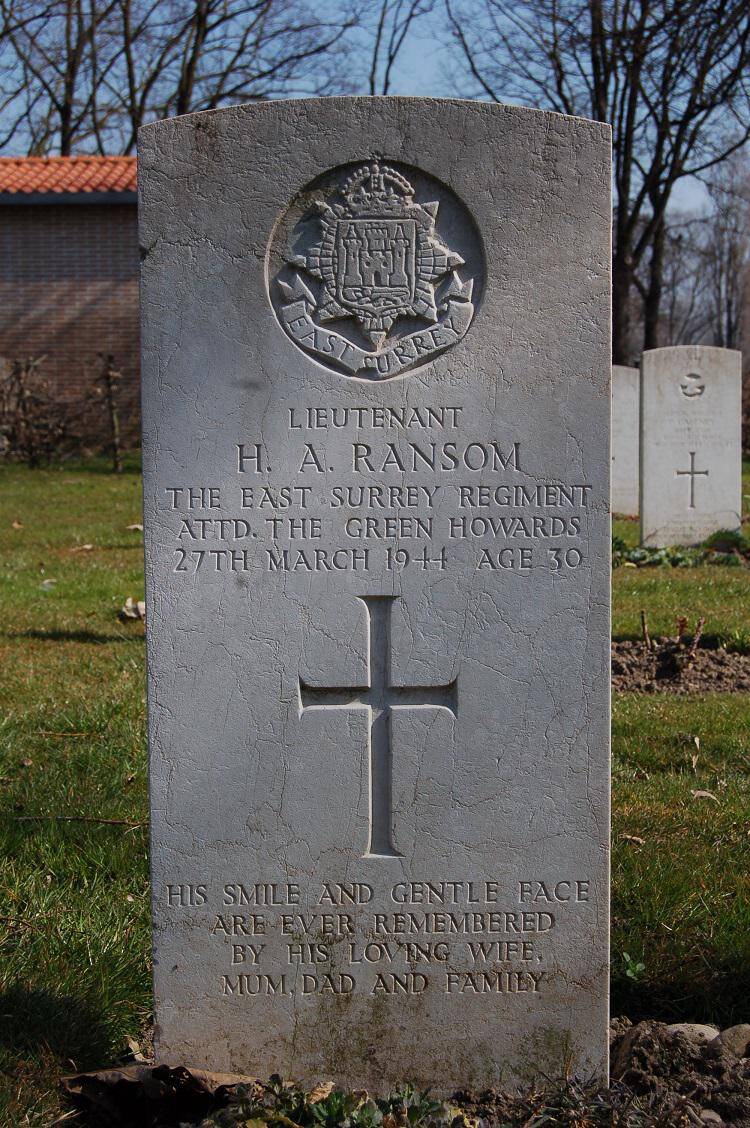
Photo: Fulvio Vigna
Lieutenant Ransom was wounded and taken prisoner on 28 December 1943. Five days earlier his battalion had taken the Abruzzo town of Arielli (CH).
On 28 December at 0830 a platoon from D Company, with one half under the command of a sergeant and the other under the command of Lieutenant Ransom, set out to patrol an area near Le Piane. The War Diary reports that at 1100 the half commanded by the lieutenant came under fire near Le Piane from machine guns and hand grenades. The lieutenant was injured and could not catch up with the rest of the platoon. The sergeant, who had moved ahead, went back to see what had happened during the shooting and met the second half of the patrol, but found no trace of the lieutenant. At 1300 he returned with the patrol.
Wounded, Lieutenant Ransom was taken to a German military hospital in Lombardy and died on 27 March 1944 from his injuries. His inital burial was in the German cemetery of Gardone.
Two other wounded prisoners who subsequently died were initially buried in the same cemetery; they were 4469343 Private Leslie William Smith (16 Durham Light Infantry) taken prisoner on 29 September 1943 at Salerno, and 2700446 Guardsman George Wilson, Scots Guards, taken prisoner between 30 and 31 January 1944 at Cassino - they were transferred with Lt. Ransom from Gardone to Milan.
Sources: War Diary 1 Green Howard Regiment WO 169/10218, December 1943
https://www.lagodigardaveneto.com/index.cfm/it/arte-cultura/attrazioni-lago-garda/cimitero-tedesco/
THE OTHER PRISONERS WERE ALL ESCAPERS WHO HAD LEFT THEIR CAMPS FOLLOWING THE ARMISTICE OF 8 SEPTEMBER 1943.
For ten of them there is information regarding their initial burial but nothing regarding the reasons for death.
To find this out it would be necessary to obtain their service records, or request their prisoner of war records from the International Red Cross, Geneva.
Number
114497
6403570
3051192
2931090
2585813
6022140
6022096
4458994
5506613
4806633
Rank & Name
Gnr D.K. KETH
Pte Alfred J. BATES
Tpr George LEGG
Pte Ewen FERGUSON
Vivian MULROONEY
Pte Jack TWIDDY
Pte Norman J. WATKINS
Pte Joseph ATHERTON
L/ Cpl J. ALEXANDER
Pte Joseph SMITH
Unit
S.A.A.
4 R. Suss.
7 R.T.R.
2 Q.O.C.H.
R.C.S.
Essex
Essex
8 D.L.I.
2 Hamp.
4 Gn. How.
Date of death
18/09/43
07/11/43
26/10/43
15/10/43
12/01/44
29/03/44
15/01/44
08/10/44
25 /11/43
01/12/43-31/05/44
Camp
PG 54
H203
PG 53
PG 73
PG 70
NCG
PG 68
PG 62
PG 59
PG 53
Initial burial (Municipal Cemetery)
Turin.
Castione Arlenico
Castione Arlenico
Castione Arlenico
Castione Arlenico
Castione Arlenico
Castione Arlenico
Orzivecchi
Garzeno
Passo di Portula
Grave
1.C.7.
II.B.8.
II.B.10.
II.B.12.
II.B.14.
II.A.12.
II A.14.
IV.A.15.
IV.C.15.
II A.2.
Private Joseph SMITH, 4 Green Howards
Recovered from the Passo di Portula
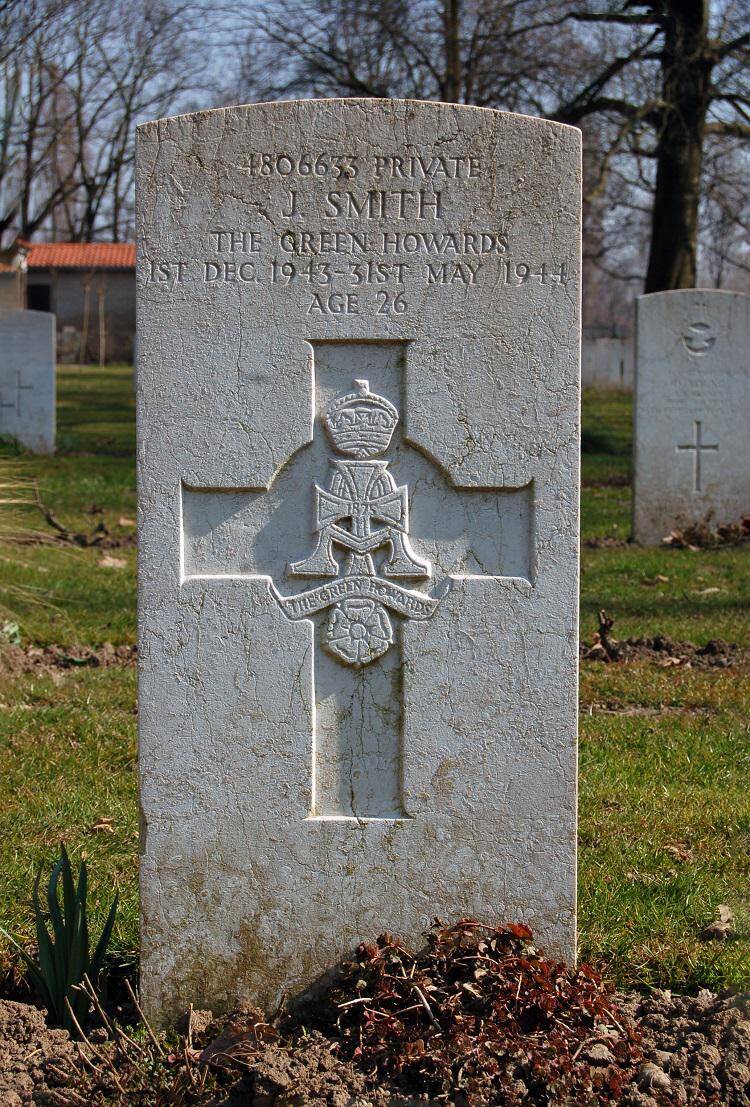
Private Joseph Smith was declared missing on 4 June 1942 in the Western Desert near Gazala when the battalion was surrounded by Rommel's troops. His status as a prisoner of war was confirmed in a document dated January-February '43, but before this time he had already been transferred to Italy.
He was interned in Camp PG 53 Macerata before being moved to a labour camp in the north. (To find out which one, it would be necessary to obtain his prisoner card from the International Red Cross in Geneva.)
After the armistice he escaped from this camp like so many others and died on an unknown date, according to the Commonwealth War Graves Commission between 1 December 1943 and 31 May 1944, probably during an attempt to cross the mountains, perhaps to reach Switzerland. His body was discovered at the Passo di Portula.
Sources:
The National Archives WO 392/21 Imperial Prisoners of War held in Italy
The National Archives WO 417/53 War Office Casualty Lists 1\939-45 Other ranks
Commonwealth War Graves Commission concentration form
Photo: Fulvio Vigna
For South African Sergeant C.A. VAN NIEKERK, of the military police, no initial burial place is given. The C.W.G.C. should be able to supply further information.
Number
197074
Rank & Name
Sgt C.A. VAN NIEKERK
Unit
S.A.P.
Date of death
03/11/43
Camp
PG 65
Grave details
IV.C.12
ESCAPE FROM A TRAIN
Sub/Lieutenant Peter Philip Col Bateman
H.M.S. Hereward, Royal Navy

One of the eighty-nine survivors of the HMS Hereward, which was sunk off Cape Sideros by a Ju 87 on 29 May 1942, Sub/Lt Bateman spent some time in the water before he was rescued and taken prisoner. He was a skilled evader, and went so far as to steal a boat in Bari before being sent to Gavi 'punishment camp' - PG 5. After the armistice he was part of a small group who decided to jump off the train carrying the prisoners of war in Germany. The last to leave the train, he was shot and killed. When on 11 March 1946 Graves Registration Unit no. 12 went to collect him from the municipal cemetery of Corvino S. Quirico, they were handed the following very detailed account by the local magistrate:
In the year 1943 on the fourteenth of September, in Fumo di Corvino S. Quirico, I the undersigned, Dr. Salvatore Giallombardo, magistrate, assisted by the undersigned registrar, report as follows:
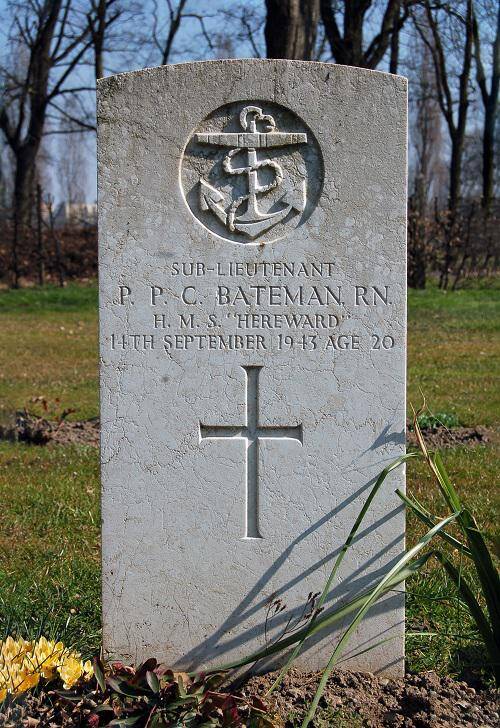
Photo: Fulvio Vigna
The body of a male person was lying supine on some grass next to the railway line, at a distance of about ten metres from the embankment, near the level crossing house situated at Km 50 + 335 on the Alessandria-Piacenza line. He was wearing a dark blue woollen pullover over a white vest, long blue mariners’ trousers, brown military-type shoes and short underpants. A leather belt on which was written ‘Sateman’ was holding up the trousers.
On the body were found: a tin chocolate box stamped with the words ‘Emergency Rations – to be consumed only when no other rations of any kind are procurable’ etc.; a matchbox with a trademark of three heads, containing a copper key, a penknife with a mother-of-pearl handle with the words ‘Ricordo di Napoli’ engraved on it, and a steel chisel stamped with the letters B.R. 444-3407, a bar of soap with the words Crest Toilet on one side and on the reverse other words of which only the word Canada is legible, a box of ‘Ovaltine’ sweets (A. Wander, London). Inside the chocolate tin there was a map showing Northern Italy as far as the Swiss border, and next to the locality ‘Campo Ligure’, written in carbon copy, was the number 472.
The body was that of a young man of around 24 years old. Blond hair, pale complexion, high forehead, regular nose, grey eyes, height about 1.76 metres, normal stature, left ear lobe attached. There was bruising on the forehead and on the lips, which were swollen. A wound with a diameter of about 1 cm. was noticed on the left side of the abdomen with a corresponding larger exit wound with jagged edges on the right buttock.
The crossing-keeper of section 50-335, 35-year-old Signora Letizia Montagna, daughter of Cesare, from Pietro de Giorgi, alerted us and gave the following testimony: ‘During the night at about half past three, a train carrying prisoners of war was in transit, direction Piacenza. At a given moment I heard a series of shots being fired. The train continued on its journey. This morning, when raising the level crossing gates, I noticed that close to the railway line, on the grass, there was a human corpse. At that point I went straight to the carabinieri of Casteggio.’
Given that the body could not be identified, once brought into the Prefecture it was photographed (photographer Ernesto Sangiorgi of Casteggio). A copy is attached to this statement.
Salvatore Gallombardo (Magistrate)
Giuseppe Fugazza (Registrar)
Photo: Fulvio Vigna
ACROSS THE MOUNTAINS
THE COLLE GALISIA TRAGEDY
In November 1944, during a blizzard, twenty four British and South African escapers and thirteen partisans, who were acting as guides, died in an attempt to cross the Alps into liberated France.
Number
4276229
6337018
76117
1515791
3909259
3712896
5256060
6291737
Rank e Name
Fus John J. STEPHENSON
L/Bdr William T. ANDERSON
Spr D. M. LEE
Gnr William D. STENNING
Pte Haydn J. ROGERS
Pte George S. HALDANE
L/Cpl Frank LEE
Pte Horace B.SLADDEN
Unit
1 N'd.Fus.
164 Fd.Regt. R.A.
4 Fd.Coy, S.A.E.C.
52 Lt.A.A. Regt. R.A.
S. W. B.
1 K.O.R.R.
1 Worc.
5 Buffs
Date
12/11/44
12/11/44
12/11/44
12/11/44
12/11/44
12/11/44
12/11/44
12/11/44
Camp
PG 65
PG 73
Work Camp
PG 65
PG 65
PG 60
PG 65
PG 98
Grave
II.C.12.
II.C.14
II.D.8.
II.D.14.
II.D.15.
II E.3.
II.E.7.
II.E.13.
Initial burial: Fornet, Val d'Isère.
The camp shown is the last in which the prisoner of war was registered by the International Red Cross WO 391/21 The National Archives, London
The Concentration Form of Commonwealth War Graves Commission, shown below, indicates that the another thirteen victims, not identified, are buried as follows:
II.C.4., II.C.8., II.C.10.
II.D.2, II. D.4, II.D 6, II.D.10, II.D.12.
II.E.1., II.E.5., II.E.9., II.E.11.,II.E.15.
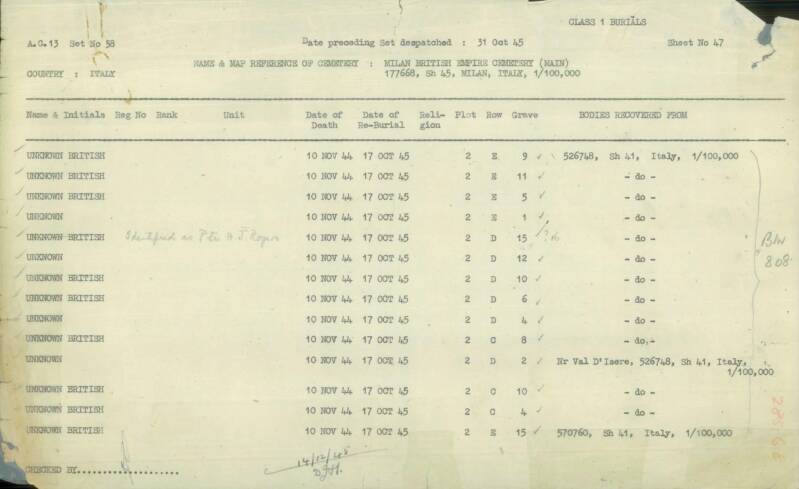
Private Haydn John ROGERS
South Wales Borderers
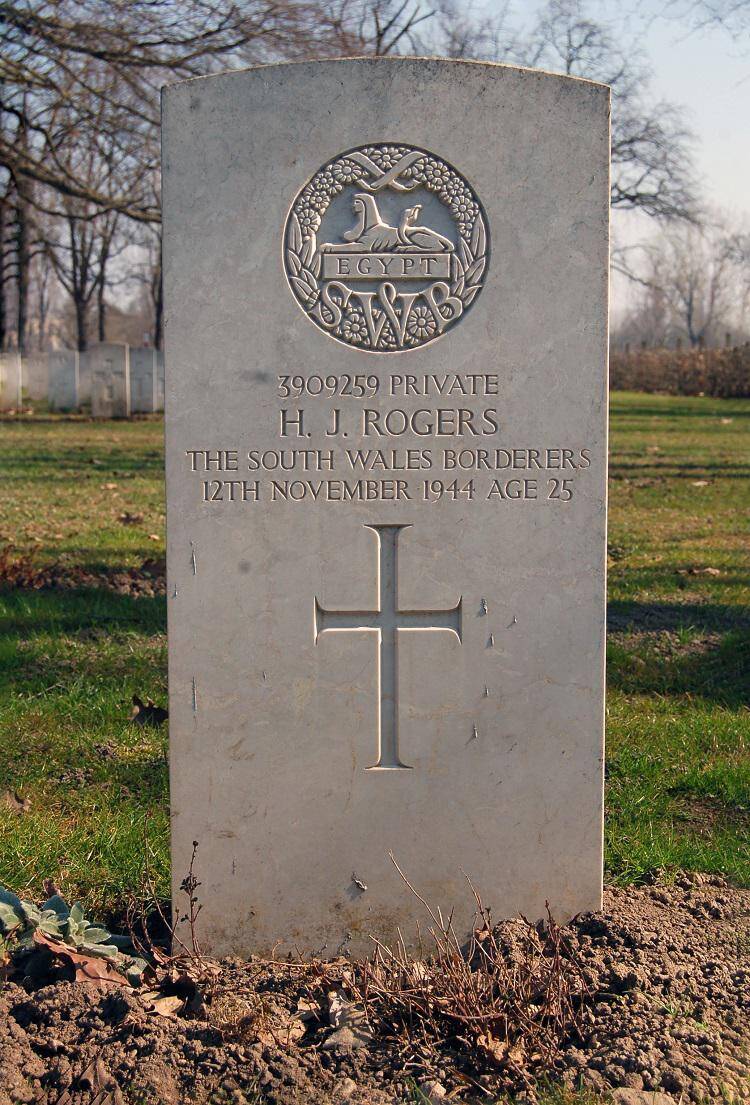
Photos: Fulvia VIgna
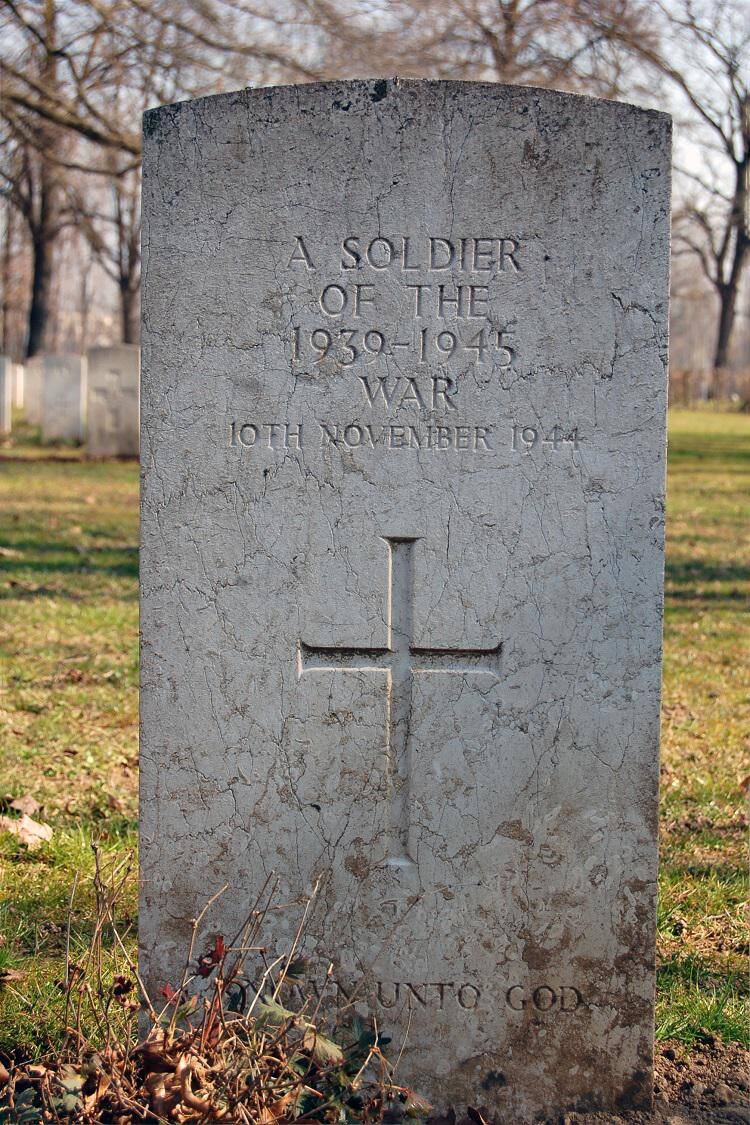
When twenty-one bodies were recovered in May 1945 only seven were immediately identified. That of Private Rogers, initially unidentified, was later recognised. After an initial burial in Fornet cemetery near Val d'Isère, all the bodies were brought to Milan War Cemetery and reburied on 17 October 1945.
It is interesting to note that while the date of death inscribed on Private Rogers' tombstone is 12 November 1944, a date of death of 10 November has been allocated to the unknown soldier in the photograph above, brought in from Fornet on the same day.
Private Jack Rogers had been in lodgings with Signora Oliva Silini, who wrote the letter reproduced below in response to an invitation to all those who had helped the 'escapers' to make a request for compensation to the Allied Screening Commission.
Dear National Liberation Committee for Piedmont, Turin
The undersigned Silini Oliva, resident in Colleretto Castelnuovo, via Castelletto n.13, province of Aosta, claims to have hidden in her house, and provided with accommodation and food the following British prisoner of war:
Jack Rogers, 28 Middle Street, Pontygwaith, Rhondda Valley, South Wales
He belonged to the infantry and had been taken prisoner in Tobruk. He was then taken to Castellamonte to work at the Giraudo 'Alta Italia' tannery from where he escaped on 8 September 1943. He was hidden in the house in early Nov. 43 and provided with food, accommodation and clothing uninterruptedly until 4 Nov. 1944. He was supplied several times with money, and in particular upon his departure, the total amount being approximately of L.800 (eight hundred). She exposed herself to those risks common to all helpers.
On 4 November Rogers left for the French border in a group with several other prisoners, led by the partisan lieutenant Vittorio. Since then there has been no news of him.
Yours faithfully
Oliva Silini
Turin, 2 June 1945
Sources:
Turin, Archivio ISTORETO, Fondo Borghetti CFB 1b
Commonwealth War Graves Commission
See also : Claretta Coda, Helpers & POW, Orco Anthropologia, Edizioni Corsac, Cuorgné, 2016
IN HOSPITAL
Before the Armistice New Zealanders Signalman George C. Darroch and Private Percy H. Bartrum were being held in Campo PG 106 Vercelli, and British Gunner John M. Burdett in Campo PG 73 Fossoli (Carpi di Modena). Lance boombardier R.LGrace, a South AFrican , was in PG 52, Pian di Coreglia, Chiaveri.
Number
17035
23881
1024879
16457
Rank & Name
Sgm George C. DARROCH
Pte Percy H. BARTRUM
Gnr John M. BURDETT
L/Bdr R. L. GRACE
Unit
2.N.Z.E.F.
23 Bn., 2.N.Z.E.F.
72 Fd. Regt. R.A.
1 A.A.Regt., S.A.A.
Date of death /Hospital
22/12/43 Vercelli
31/03/44 Vercelli
07/10/43
24/05/44 Castelsangiorgio
Cause/ Inital burial (Municipal Cemetery
Not specified/Vercelli
Meningitis/Vercelli
Peritonitis/Luzzara
Died of wounds sustained when in combat with partisans/
Castelsangiorgio
Grave
III.B10.
III B11.
V.A.7.
III.D15.
Lance Bombardier R. L. GRACE
1 A/Aircraft Regiment South African Artillery
According to Italian website museo_resistenza_ piacentina_it a partisan by the name of J. W. Greys, from Cape Town, wounded in action at Bettola on 3 April 1944, died in hospital at Castelsangiovanni on 11 May 1944.
Private Percy Harold BARTRUM
23 Battalion 2 New Zealand Expeditionary Force
The New Zealander died in the Ospedale Maggiore in Vercelli on 31 March 1944. His parents were told that he had been 'Shot by enemy guard after escaping from POW camp', but when the Graves Registation Unit of the Commonwealth War Graves Commission collected him from Vercelli municipal cemetery for transfer to Milan they recorded that he had died of meningitis.
A compatriot of his, 17035 Signalman George Caldwell DARROCH, New Zealand Corps of Signals, died in the same hospital on 22 December 1943. The Graves Registration Unit was not given cause of death. He is buried in Section III, Row B, Grave no. 10 next to Private Bartrum.
Sources:
Commonwealth War Graves Commission
Percy Harold Bartrum: Bereavement card, North Auckland Research Center, Takapuna Library, McVeagh collection, T7663, New Zealand

Photo: Fulvio Vigna
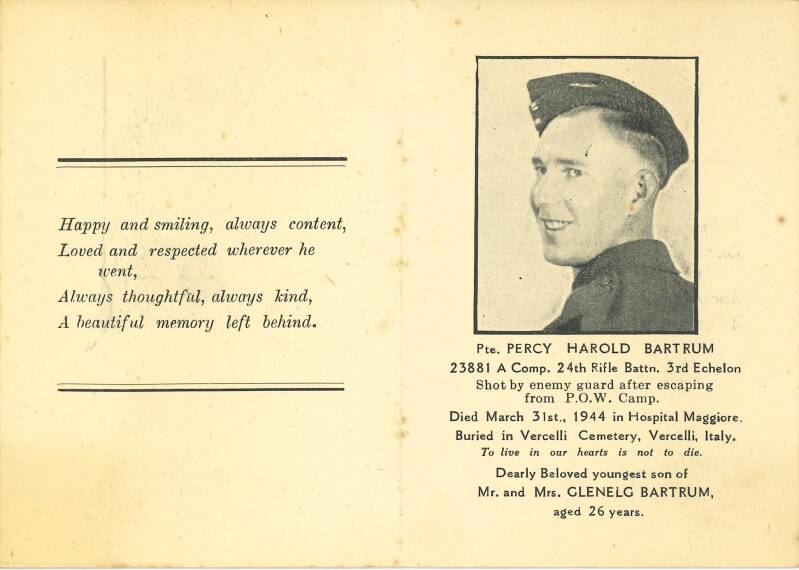
WITH THE PARTISANS
In Document WO 417, British Army Casualty Lists 1939-45, the cause of death of four of the following escaped POWs was given as death in combat. For the fifth, information comes from a website and a newspaper article.
Number
4914235
4976114
6022221
840921
WX/14394
6400406
Grade / Name
Pte E. JACKSON
Pte T. H. BALL
Cpl R. L. DIX
Gnr H. DARBYSHIRE
Pte L.A. PARKER
Pte John MURRAY
Unit
1 Fors'ters
1 Fors'ters
2/5 Essex
28 Fd. R.. R.A.
2/32 Bn. A.I.F.
4 Royal Suss.
Date
18/01/44
20/03/44
29/12/44
15/01/45
13/08/44
02/12/44
Camp
PG 70
Work Camp
PG 53
PG 53
Work camp
PG 70
Source
WO 417/102
WO 417/101
WO 417/102
WO 417/102
Newspaper
CWGC
Initial burial
Piacenza
Chiotti
Viale
Casale
Torrazzo
Castello di Annone
Grave
IV.E.1.
I.D.11.
IV.E.3.
IV.A.11.
I.E.14.
VI.C.8.
Private Leslie A. PARKER
2/32 Battalion, Australian Imperial Force
Private Leslie A. Parker, after having been wounded during a guerilla action near Issime in the Val di Gressoney was taken to Baita Amici where he was given first aid. He was then transferred to Torazzo to the home of the priest, don Pastoris , where he died on 13 August.
Sources: https://www.bocciodromodellaserra.it/LiveinTorrazzo.pdf
The Daily News Perth Sat. 23 Feb. 1946 Page 9.

Photo: Claretta Coda
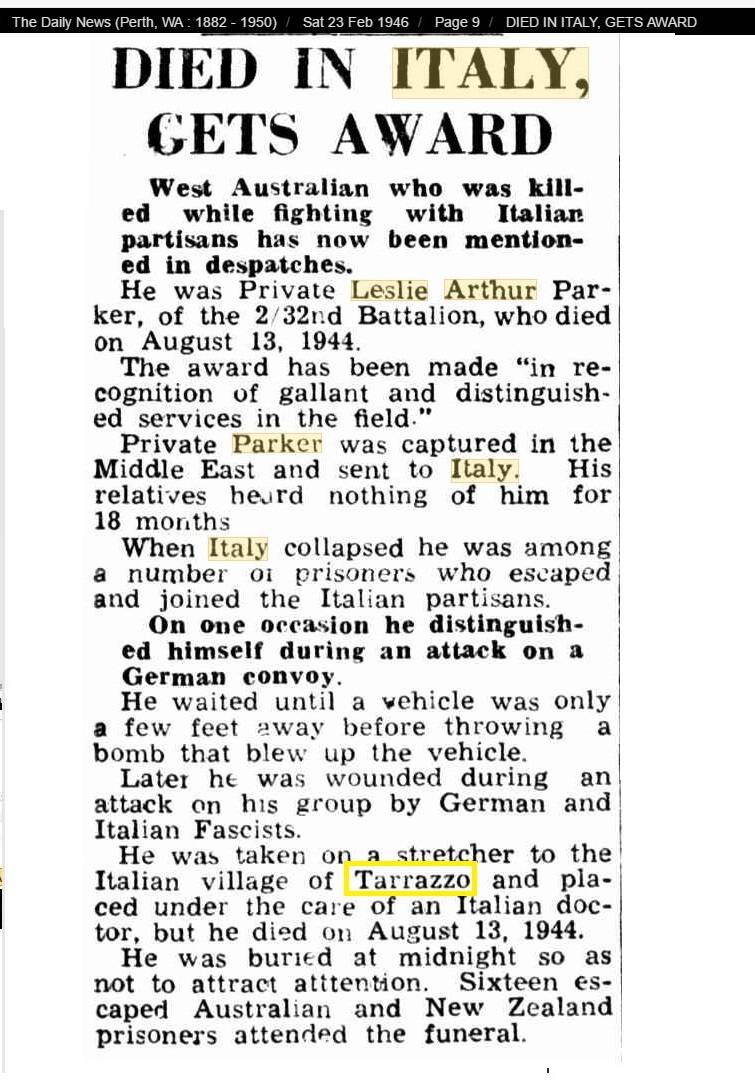
KILLED BY THE NAZI-FASCISTS
The circumstances in which all the prisoners in this list were killed were considered as consitituting a possible war crime. The enquiries into their deaths, carried out by the British judiciary authorities, (the Judge Advocate General) may consulted in the National Archives, London, or ordered on line.
Number
925409
S/119817
4974424
1515743
1796455
894797
2328492
12626
WX11952
3314081
847083
VX45756
61235
37158
VX42361
WX10591
VX46586
VX.1664
WX7090
WX14978
T/130496
4394107
854578
4346320
848475
4392670
896957
Rank & Name
L/Sgt Frederick W. EDWARDS
Cpl Arthur A. FARROW
Pte John F. TERRETT
Bdr Benjamin L. MITCHELL
Gnr William C. S. HILL
Bdr George E. HOOKER
Sgm John FINLAY
Cpl Franklin BOWES
Pte Harry H. MILLER
Cpl William BROWN
Gnr Fred MILLER
Pte James C. McCRACKEN
Gnr Leslie G. BATT
Pte John T. CLARK
Pte Douglas SMEDLEY
Unidentified soldier
Pte William G. HARVEY
Pte Harold R. BLAIN
Dvr Clive E. LIDDELL
Cpl John R. NICHOLLS
Pte Ernest S. WOLFE
Dvr Geoffrey G. WILLSON
Pte Richard BRINDLE
Gdmn Henry C. COCKBURN
Pte George BAMBRIDGE
Sgt Percy DUNMORE
Pte Arthur BAILEY
Gnr Robert DICKINSON
Unit
7 Med. Regt. R.A.
R.A.S.C.
1 For'ters
75 L.A.A. Regt. R.A.
61 Lt. A.A. Regt. R.A.
107 Regt. R.H.A.
1 Armd. Div. Sigs.R.C.S.
26 Bn. 2NZEF
2/28 Bn.A.I.F.
2 H.L.I.
1 Fd. Regt. R.A.
2/24 Bn. A.I.F.
14 Lt. A.A. Regt.,RNZA
25 Bn.,2 NZEF
2/23 Bn. A.I.F.
2/32 Bn. A.I.F.
2/24 Bn. A.I.F.
9 Div. A.I.F.S.C.
2/28 Bn. A.I.F.
2/32 Bn.A.I.F.
1 Armd. Div. R.A.S.C.
5 Gn.How.
3 C.G.
4 East Yorks.
31 Fd. Regt. R.A.
7 Gn. How.
60 Fd. Regt. R.A.
Date of death
25/09/43
25/09/43
25/09/43
12/12/43
03/01/44
03/01/44
18/01/44
21/02/44
21/02/44
15/04/44
15/04/44
15/04/44
24/04/44
24/04/44
24/04/44
08/05/44
08/05/44
08/05/44
08/05/44
08/05/44
08/05/44
31/07/44
01/08/44
20/05/44
20/05/44
18/10/44
03/01/45
03-05 03/45
Camp
PG 66
PG 29
PG 73
PG 66
PG 53
PG 112
PG 53
PG 106
PG 106
PG 73
NCG
PG 106
PG 106
PG 106
PG 57
PG 57
PG 57
PG 57
PG 57
PG 57
C.D.L.
PG 65
PG 65
PG 53
PG 53
PG 53
PG 53
Grave details
III.E.1-.3
III.E.1-3.
III E.1-3.
1.D.4.
IV.B.1.
IV.B.3.
III.D.13.
VI.B.4.
VI.B.5.
III.C.10.
III.D.2.
II.D.3.
V.B.5.
V.B.6.
V.B.7.
III.C.4.
III.C.5.
III.C.6.
III.C.7.
III.C.8.
III.C.9.
III.C.13.
I.D.13.
I.E.1.
I.E.2.
IV.C.13.
IV.A.13.
IV.B.13.
Gunner Robert Dickinson
60 Field Regiment, Royal Artillery

Photo: Claretta Coda
Taken prisoner in North Africa on 24 November 1941, for a period Gunner Robert Dickinson was interned at PG 59 Servigliano, then transferred to PG 53 Sforzacosta and from there he was sent to PG112/4 work camp at Gassino (Turin) in the summer of 1943. At the armistice he escaped with his friend Ronald Dix and was hosted by the Bauducco family in a farmhouse in Via Armando Diaz in Gassino for a year.
On 2 February 1945 Gunner Dickinson joined the partisans of the 2 Raggruppamento, Divisione Paolo Braccini, G.M.O. Aldo Brosi. Wounded in an encounter with some Nazi-fascist troops on 3rd March 1945, he asked his companion to leave him in a ditch with his weapon, but unfortunately he was found by the enemy and brutally killed some time between the 3-5 March. His Royal Artillery Casualty Card reads: Killed in action while at large in enemy-occupied territory.
Initally buried by the partisans in Viale (Asti) municipal cemetery, from there he was transferred to Milan War Cemetery on 13 December 1945.
The British Military Police Special Investigation Branch (S.I.B.) opened a file on his death, but it was not possible to prosecute as it was impossible to trace the perpetrators:
TNA: WO 32/22163: Investigation into death of British soldier Dickinson R., Gunner, 896957, 60th Field Regiment, Royal Artillery, an escaped POW.
Gunner Dickinson wrote a diary that can be consulted online:
Sources:
Coda Claretta, A Strange Alliance, Città Metropolitana di Torino, 2022, p.47
Fulvio BorghettI Diario clandestino, Archivio Istoreto, Torino, Fondo Borghetti, C FB 9, p. 868.
Lance Sergeant Frederick W. EDWARDS, 7 Medium Regiment, Royal Artillery
Corporal Arthur A. FARROW, Royal Army Service Corps
Private John F. TERRETT, 1 Battalion Sherwood Foresters
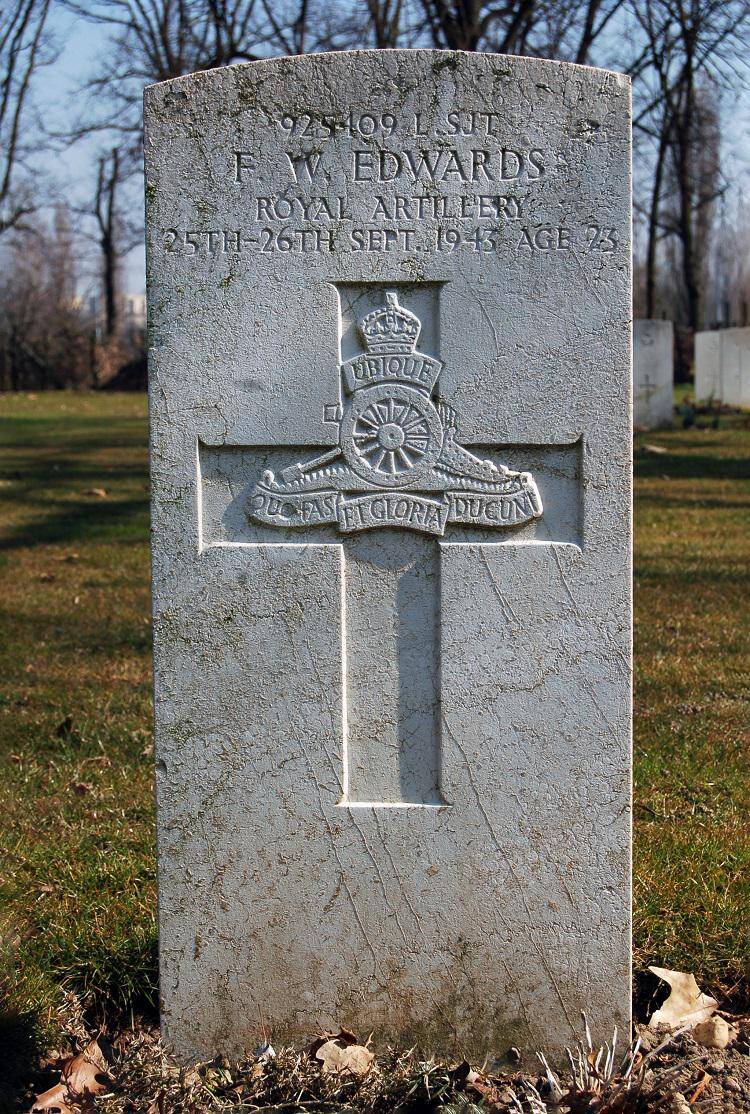
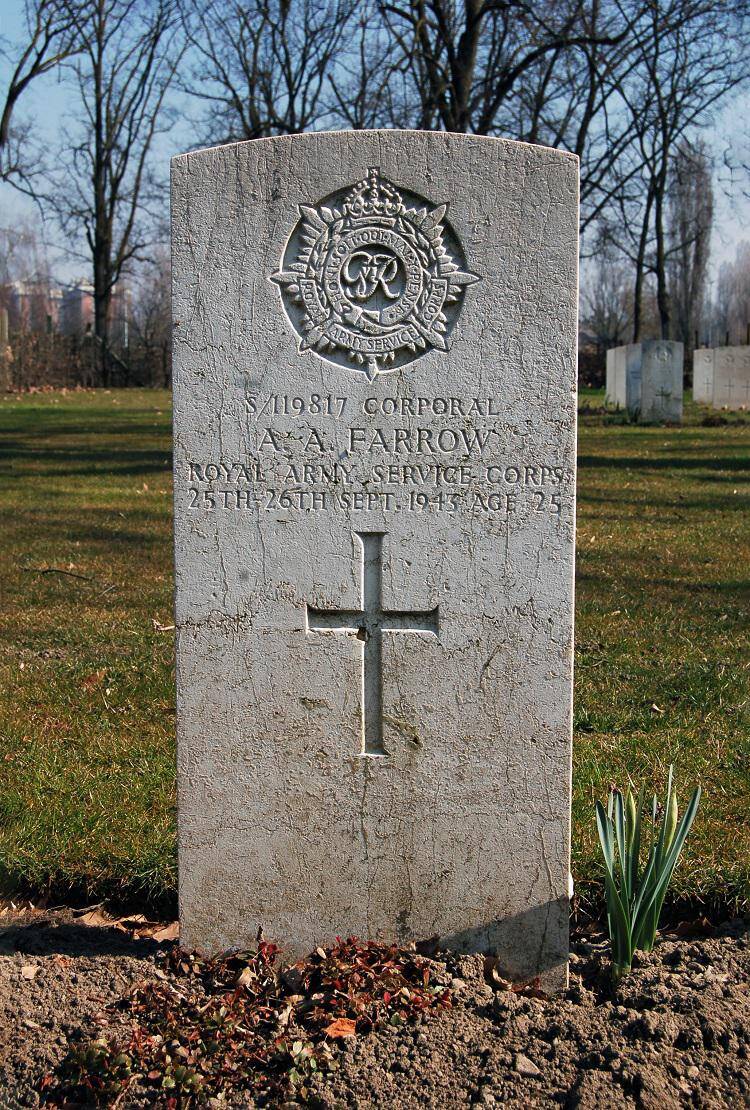
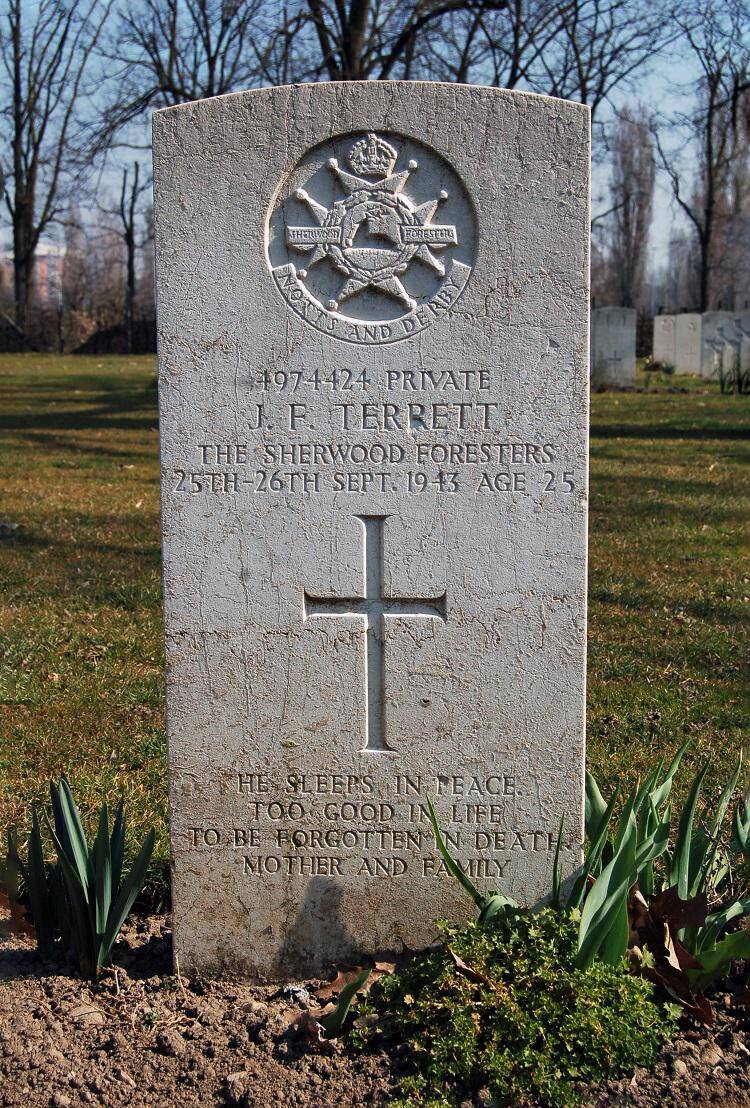
Photos. Fulvio Vigna
Soon after the Armistice, whilst the Germans were preparing to send all the prisoners from PG 73 Fossoli to Germany, Austria or Poland, the three above soldiers were in a group which was trying to escape. Below are two testimonies:
5251607 Private D.S. Goodchild, Worcester Regiment.
The evening of 25 September was dark and rainy. He and some others, one of whom he recognised as being Lance Corporal Edwards, emerged from their hiding place and made for the fence which ran along the side of the canal. Having cut the wire they went through, but immediately afterwards a guard was heard to shout ‘Halt’ and began shooting. Private Goodchild testified that a sergeant, a friend of Lance Corporal Edwards whose name he did not know, was killed.
2696687 Lance Corporal Geoffrey Johnstone, Scots Guards
A German guard ordered me and two sergeants to dig a grave for three dead soldiers near to the road, on the north side of the football field used by the Italians. None of us was given any food for the entire day...We finished up digging the grave...that afternoon the three soldiers were buried. One of the British officers led the ceremony whilst the Germans planted a cross on which were written the following words: ''Three unknown British soldiers''.
The parish priest of Fossoli (Mo), don Francesco Venturelli, wrote in his diary:
30 September 1943. I received permissioni from the Mayor of Carpi and the Prefect to exhume the three British soldiers who had been buried without a coffin in a field near the road (Strada dei Grilli).
2 October 1943 […]. Today, with the permission of the authorities they were exhumed and were found to be in the first stages of putrefaction and without any form of identity in their pockets...they were numbered N° 1, 2 and 3... after the funeral rites... they were transferred to Carpi Municipal cemetery.
The three were then taken to Milan to be reburied. The Grave Registration Card on the cwgc website shows them to have been buried in a common grave, but in fact there are three separate headstones as shown above.
Sources: The National Archives, London:
TS 26/456: Carpi: Mass Murder
WO 310/20: PG 73 Carpi: shooting of British POWs
Gunner Leslie G. BATT, 14 Light Anti-Aircraft Regiment, Royal New Zealand Artillery
Private John T. CLARK, 25 Battalion, 2 New Zealand Expeditionary Force
Private Douglas J. SMEDLEY, 2/23 Battalion, Australian Imperial Force
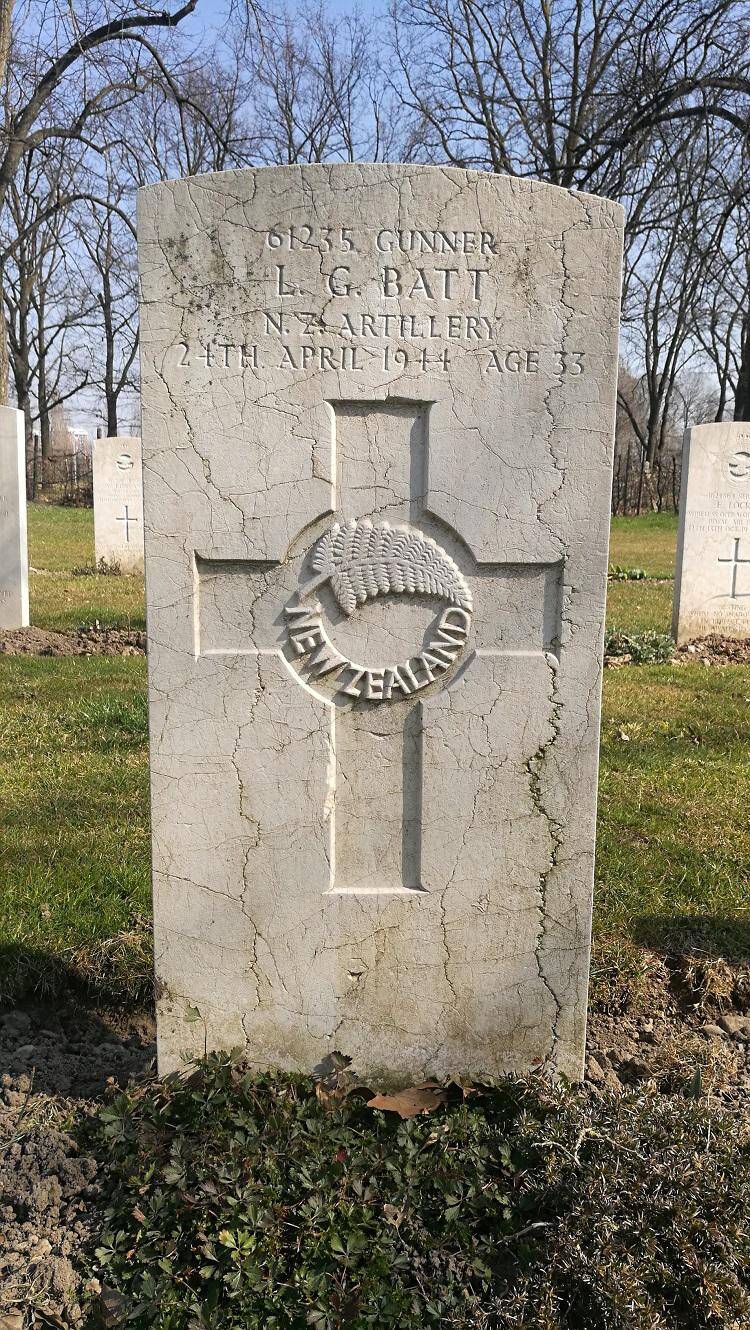

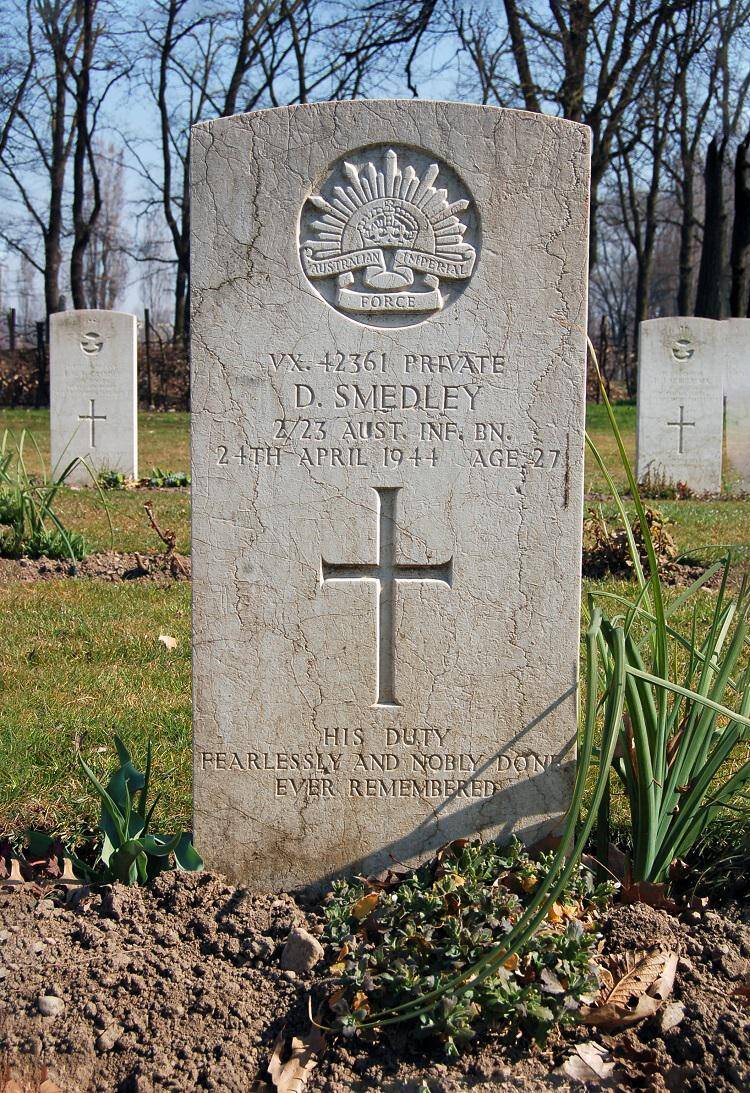
Photos: Fulvio Vigna
The three 'escapers' listed above were killed in April 1944 by fascists belonging to the 115 ° Reggimento 'M' Montebello, a unit whose task it was to hunt down partisans and escapers. One of their comrades, Australian NX2777 Private Raleigh Edward Hoy, 2/3 Pioneer Battalion, called to testify on his return to Australia, explained that he had escaped from camp 106/2 Vercelli after 8 September and had met up with Private Smedley in the village of Coggiola beyond Trivero in the biella district of Piemont.
He explained in his affadavit that they continued to hide in the mountains waiting for a favourable opportunity to cross the Alps. In mid-April 1944 they met several other escaped prisoners of war in a village about halfway between Andorno Micca and Mosso Santa Maria, amongst whom were Private John T. Clark and Gunner Leslie G. Batt. There were seven of them in all, and they lived in a stone shelter about a mile north of the village.
In the shelter where they were staying there were four bedrooms on the first floor and Clark, Batt and Smedley slept in a room at the north end. Private Hoy and the other three - WX77218 Private J. Brennan and WX/6905 Private Fogg (both of 2/28 Battalion) and QX/7639 Private E. Albert (2/15 Battalion) slept in a room on the other side of the farmhouse. On the morning of 24 April 1944 they were awakened by the sound of gunshots. Private Hoy jumped out of bed, looked out the window, and saw about fifteen fascist soldiers outside. He knew a few words of Italian and understood that their leader was telling them to go into the farmhouse to see if there was anyone inside. They were to bring out whoever they found and then set the place alight. The four began to dress but before they had finished the fascists came up the stairs to their room, ordering them to go outside with their hands up. Three armed fascists then escorted them out of the house and told them to stand against the wall of the small cottage next to the farmhouse. A machine gun was pointing at them. They told the fascists that they were British prisoners of war and the officer, who was a short distance away from the farmhouse, shouted in Italian: "Don't shoot these four. We'll take them prisoner." He yelled about four times at the fascist sergeant. As they were dragged away they noticed the bodies of Clark, Batt and Smedley.
Two of the soldiers of the Montebello regiment were tried in Bologna on 26 August 1946 and found guilty. One, Pietro Mussetti, was sentenced to death by shooting, the sentence being carried out on 20 December 1946, the other was sentenced to twelve years imprisonment. He was freed by the Italian government for good conduct in August 1949.
R.E. Hoy. Affidavit, Sydney, New South Wales, 17 01 1946. The National Archives of Australia
The National Archives:
WO 310/65: Biella Italy. Shooting of New Zealand and Australian POWs.
WO 311/338: Biella Italy. Killing of three re-captured allied POWs.
Coda Claretta, Helpers & POW, CORSAC, Cuorgné , 2016
Private Richard Brindle, 5 Battalion Green Howards
Killed by some fascists at San Gillio (Province of Turin) on 25 July 1944

Photo: Fulvio Vigna
A villager named Davide Cambiano gave the following testimony:
[A woman called] Margherita Peracchino was killed during an ambush set by the fascists for four partisans on 25 July 1944, and I – I was 14 at the time - was a witness to part of this tragic event.
That afternoon many years ago I was at the village pump...and I was drawing water with a bucket. A car arrived from the square and stopped in Via Roma - where the pizzeria is now - the street was almost deserted. Four partisans got out of the car, two of them remained next to it (Sergio Castelli and the Britisher Robert), while the others headed towards the castle...
In the meantime, having filled my bucket, I was returning home when suddenlyI saw two open-topped vehicles appear from Via San Rocco : standing in each of them were about ten plain-clothed fully armed republicans, with machine guns at the ready.
As soon as I turned into Via Roma I noticed the car belonging to the partisans: two or three of the republicans exclaimed at the same time "There they are!" and instantly opened fire. I found myself caught up in the middle, and instinctively threw myself into the first open doorway I found, that is, into my aunt's shop.
The testimony of Piero Castelli, brother of partisan Sergio:
Sergio had joined the partisans in March 1944, or perhaps even earlier, but I first saw him armed at that time. He was in Val di Lanzo in the 19th Brigade and was killed on 25 July of the same year in an ambush. The group of 8-10 partisans, including two Britishers, to which he belonged, was on the wanted list and was constantly on the move from one farmhouse to another. That time they went down to get some supplies of butter to take up the mountains, someone had spied on them and the fascists...with their telescopes, saw the dust raised by the car as it passed along the dirt road. They calculated how long it would take to get to Via Principi and then left in two large cars, all wearing red shirts. Our lads stopped in Piazza Bovetti: Mario Castagno and two others got out to fetch the butter, and Sergio and on of the British stayed close to the car. The fascists, were disguised as partisans...Sergio raised his weapon to greet those he thought were partisans from the Val di Susa, and then the shots started: they were killed in via Roma. Mario and the others, on hearing the shots, made off in the opposite direction. The Britisher died immediately; they told me that my brother fought on, despite being wounded. He threw the last two hand grenades he had...
Sources:
https://www.anpialpignano.it/joomla30/doc-pdf/TESTIMONIANZA%20di%20Davide%20Cambiano.pdf
https://www.anpialpignano.it/joomla30/doc-pdf/fratelli_sergio_castelli.pdf
OTHER PRISONERS OF WAR WHO DIED AS A RESULT OF NAZI-FASCIST AGGRESSION
Number
213633
NX/54257
6202795
Rank & Name
S/Sgt Victor J.WHITE
Pte Ross H. MUDGE
Sgt Leslie BAGGETT
(alias WOOD)
Unit
S.A.T.C.
2/3 Bn. A.I.F.
3 C.G.
Date
13/09/43
13/11/43
11/11/43
Cause
Probably killed during march
from PG 52 -Chiavari station
See below
'Believed to have been shot during an escape attempt (C.W.G.C. Concentration Form)
Initial burial
Cicagna M.C.
Ivrea M.C.
Parma M.C.
Grave
II.A.12
III.B.15.
V.C.14.
Private Ross Harold MUDGE
2/3 Pioneer Battalion. Australian Imperial Force

Australian enlistment card
Source: Personal service records: Australian service | Australian War Memorial (awm.gov.au)
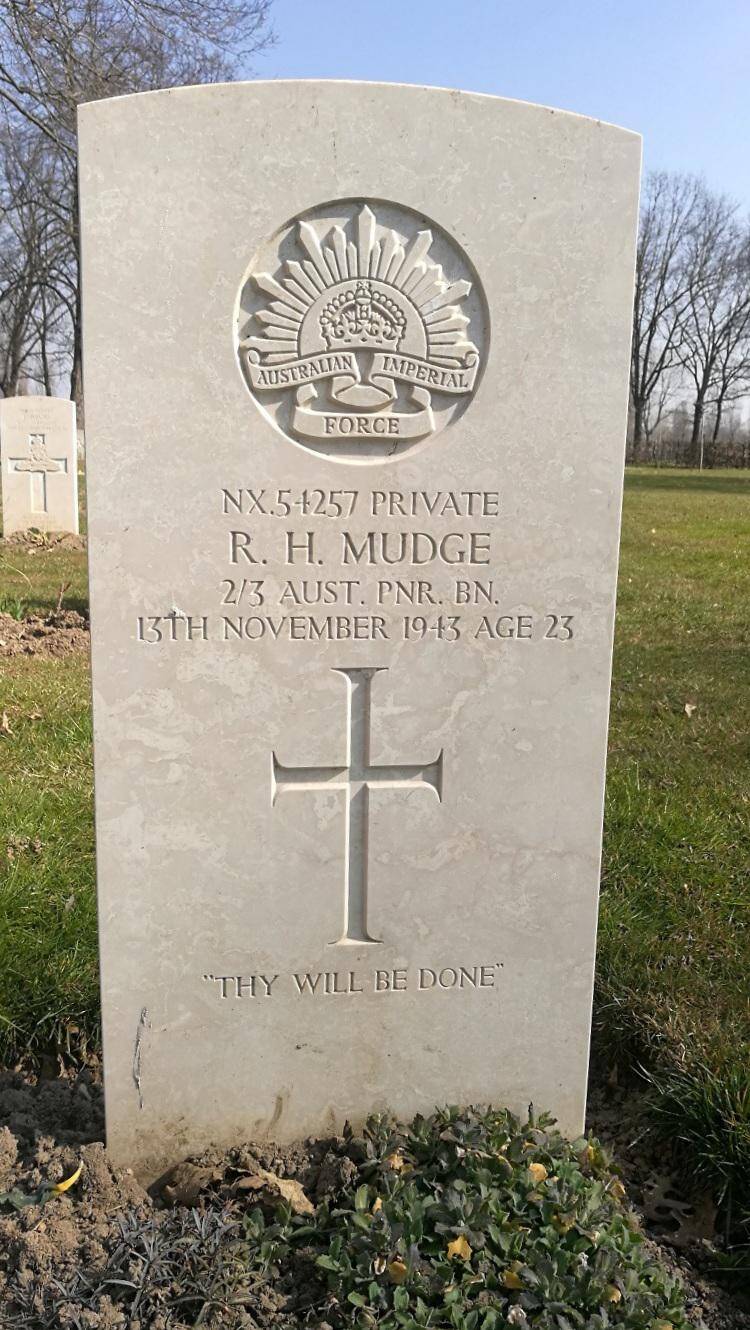
Photo: Claretta Coda
Private Ross Harold Mudge escaped from Camp PG 106 Vercelli at the armistice, and was killed in Chiaverano in the Calveis region of Piedmont by a nazi-fascist collaborator on 13 November 1943. Defending himself with a metal tool, he tried to escape from a farmhouse where he was hidden with other escaped prisoners. Wounded in the thigh and chest, he was taken to Ivrea hospital where attempts to save him were in vain. He was buried in Ivrea municipal cemetery from where, after the war, he was transferred to the British & Commonwealth War Cemetery in Milan.
The sentence issued against the killer by the Extraordinary Court of Assizes of Ivrea on 30 October 1945 reads as follows:
"The killing undoubtedly constituted the crime of murder...the accused was facilitated by the fact that the poor victim was deprived of any possibility of private defence.”
The court ordered that the accused be sentenced to death by shooting in the back ... It ordered that the assets of the accused be confiscated for the benefit of the state.
Source:
Coda Claretta, dall'Archivio Istoreto, Fondo Sentenze della Magistratura piemontese
Four unidentified escapers were killed by some fascists. Their bodies were found in the River Stura.
Rank e Name
unknown
unknown
unknown
unknown
Date
23/09/44
23/09/44
23/09/44
23/09/44
Initial burial
Turin M.C.
Turin M.C.
Turin M.C.
Turin M.C.
Grave details
I.D.5.
I.D.6.
I.D.7.
I.D.8.
Sources
The National Archives, London WO 311/1278
WO 208/3352/2745 E &E Report Sgt T. Powell R.A.
Fulvio BorghettI Diario clandestino, ARCHIVIO ISTORETO, Fondo Borghetti, C FB 9. p. 774
WAR CRIMES FILES
The following war crimes files relating to Milan burials are held in THE NATIONAL ARCHIVES, LONDON
WO 311/1232
WO 311/1244
WO 311/1246
WO 310/20
TS 26/456
WO 310/87
WO 311/1255
WO 310/64
WO 310/65
WO 311/338
WO 310/68
WO 311/1234
WO 311/1235
WO 311/1280
WO 310/236
WO 311/ 1269
WO 310/71
WO 311/1222
WO 311/1278
WO 311/1241
WO 311/34
WO 311/312
WO 311/1219
WO 311/307
MITCHELL
Killing of British escaped prisoner of war and two Italians at Cuneo, Italy, 12 December 1943
EDWARDS, FARROW, TERRETT
Shooting of British prisoners of war at PG 73, Carpi, Italy, 25/26 September 1943
Ill-treatment and murder of British prisoners of war at Camp PG 73, Carpi, Italy, Sept. 1943
PG 73 Carpi, Italy: shooting of British POWs
Carpi: mass murder
HILL, HOOKER
Boves, Italy: killing of two British soldiers
FINLAY
Shooting of Sgm. J Finlay at Varallo, Italy, 18 January 1944
BOWES, MILLER H.H.
Mosso Italy: killing of New Zealand and Australian POWs
BATT, CLARK, SMEDLEY
Biella, Italy: shooting of New Zealand and Australian POWs.
Biella, Italy: killing of three re-captured allied POWs.
BROWN, MILLER F., McCRACKEN
Verallo, Italy: shooting of Australian POWS
Shooting of three allied prisoners of war by Italians at Varallo, Italy, 15 April 1944
HARVEY, BLAIN, LIDDELL, NICHOLLS, WOLFE, Unknown
Shooting of six allied prisoners of war at Alpe Barbera, Italy, 5 May 1944
WILLSON
Nave, Italy: killing of British POW
BRINDLE
Shooting of escaped British prisoner of war, Pte R Brindle, San Gillio Italy.
COCKBURN, BAMBRIDGE
Alleged shooting of two British prisoners of war at Selvaggio, Prov. Turin, 20 May 1944.
DUNMORE
Cavagiglia, (Cavriglià) Italy: killing of British soldier
BAILEY
Murder of British prisoner of war, Scioltze, Italy, 7 September 19441
4 unidentified found dead in the River Stura
Alleged murder of four prisoners of war at Volpiano, Italy, 15 September 1943
JONES
Shooting of Private T. Jones, (escaped prisoner of war) at Ciriè near Turin, Italy, 12 August 1944.
SMITH
Pinetti, Italy: killing of British soldier by partisans
KAHN
Camp 41, Montalbo Italy: killing and ill treatment of POWs
LAW
Shooting of Private J.E.Law (Prisoner of War) at Camp 106, Verona, Italy
TOFI
Camp 62 Orio al Serio near Bergamo, Italy. Killing of Cypriot POW.
KILLED BY THE PARTISANS
Number
3778030
843890
Rank & Name
Pte Thomas JONES
Tpr C. G. SMITH
Unit
4 East York
8 K.R.I.H.,R.A.C.
Date
12/08/44
05/04/45
Camp
PG 65
PG 53
Initial burial
Pessinetto
No information
Grave details
VI.A.14.
I.D.9.
3778030 Private Thomas JONES
4 Battalion East Yorkshire Regiment

Photo: Claretta Coda

Private Thomas Jones, 4 East Yorkshire Regiment, was shot by the partisans in what can be best described as a vendetta against the family which was sheltering him. A former prisoner in PG 65, he had escaped from PG 112/2 at the time of the armistice and had been looked after by the Bettini family of Borgata Baratonta, Varisella, near Fiano in Piedmont, for the eleven months preceding his death on 12 August 1944.
There was a rumour current in the district that Rosalia Bettini, the wife of the family, had betrayed several escaped British POWs to the enemy before she had met Jones, and that she had befriended him and sheltered him in order to clear herself in the eyes of the local partisans. In August 1943, a local partisan leader, Giovanni Battista Gardoncini, ordered her arrest. Though initially cleared of these charges she was picked up once more, and on this occasion Jones insisted opn accompanying her to her ‘trial’. She was sentenced to be shot, whereupon Jones said that ‘if she was to be shot, he wished to be shot also’. Both the woman and Jones were thereupon executed by one of Battista’s lieutenants.
For some days after the second arrest there was no news of them. Domenico Bettini searched for a fortnight and on August 27th he learnt that his wife and the British soldier had been shot at Pessinetto, in front of the Villa Rosa. The two bodies were buried in the cemetery of Pessinetto. The Bettini family had them brought to Fiano and the funeral took place there on 30 September.
There is however another more plausible reason for Rosalia’s arrest by the partisans. An extract from an Italian newspaper (undated) explained that whilst Private Jones was living with the Bettini family a partisan called Mazzini, nicknamed ‘Colonel Barbaro’, came to live in an apartment in the same building. The Bettini family and Mazzini shared the garden. The Bettini cultivated it, Mazzini took the best of the produce. One day a violent dispute arose. Mazzini slapped Mrs Bettini and uttered direct threats with his revolver. She complained to the police superintendent, who took away the pistol. The newspaper account goes on to relate how both Luciano Bettini (son of Domenico and Rosalia Bettini) and Bettini himself were later liquidated after accusing Mazzini of the murder.
It later transpired that the man suspected of having shot Rosalia and Private Jones was in fact partisan ‘Pino’, who had himself been summarily executed by the Germans. In any event, it was decided that the killing of Private Jones did not constitute a war crime, though Mazzini was to be tried under Italian law for the deaths of the father and son. He received a thirty-year sentence.
Sources: https://www.anpi.it/donne-e-uomini/1521/giovan-battista-gardoncini
WO 311/1241, Shooting of Private T. Jones, (escaped prisoner of war) at Ciriè near Turin, Italy, 12 August 1944.
Trooper C. G. Smith, Royal Irish Hussars
Trooper Smith was accused of betrayal by the partisans. After the war the War Crimes Commission opened an enquiry.
WO 311/34: Pinetti, Italy: killing of British soldier by partisans
JANET KINRADE DETHICK
Crea il tuo sito web con Webador